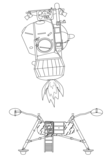 | |
| Manufacturer | Korolev |
|---|---|
| Country of origin | Soviet Union |
| Operator | Soviet space program |
| Applications | Uncrewed spacecraft around the Moon and back to Earth |
| Production | |
| Status | Program ended. One craft orbited, one craft failed |
| Built | 2 |
| Launched | 2 |
| Retired | 1971 |
| Related spacecraft | |
| Derived from | Soyuz 7K-OK and Soyuz 7K-L1 |

Soyuz 7K-L1E was a Soviet uncrewed modified Soyuz 7K-L1 spacecraft. Also called a dummy Soyuz 7K-LOK. Two were built, one Soyuz 7K-L1E was successfully launched into Low Earth Orbit on Proton rocket and is known as Kosmos 382. The other Soyuz 7K-L1E was placed on a N1 rocket, which failed at launch. The Soyuz spacecraft was first used in 1967 as the main crewed spacecraft of the Soviet Union and is still in use today. Many Soyuz variations have been built and the Soyuz 7K-L1E was an uncrewed variation. [1] [2] [3] [4]

